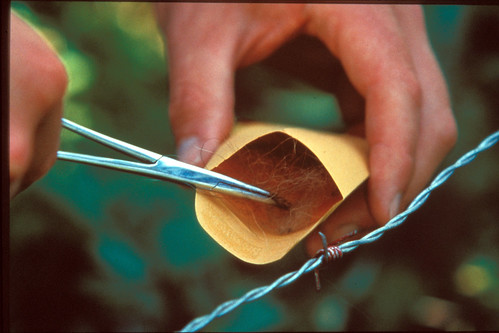
Hair and fibers are important to be collected at a crime because they can tell who is responsible for the crime. However, there particular techniques to collect hairs and fibers they do not need to be taken lightly. The human hair can define that particular person it belongs to. The examination of hair can tell what gender, race, age that person who left the human hair at the crime scene. To collect a hair sample at crime scene investigation forensic scientist students need to first have a tweezers present and pick up the hair sample. Next, take a envelope and insert the hair sample into the envelope. For the third step forensic scientist students need to label envelope of the specific name of where the hair sample comes from. Now on some occasions hair will be attached different things including blood, or caught in a crack of a glass. If this event happens you are not suppose to remove that hair sample from the object. The first step in order to collect that particular small hair is mark where hair is, then wraps the hair sample and put in an envelope. Do not forget to label the envelope of where the hair is located .
Fiber Collection Techniques
 |
| Tapelifting |
 |
| Vacuuming |
Fibers of hairs can be found in different objects such as screens, broken glasses, cars, houses, and even on animals if during the a crime scene. The fibers that are collected from a car can be sent to forensic scientist laboratory to see if they match to some victims of a crime. When examinations occur, it can reveal the different colors of the fiber and type of fiber it is such as wool, cotton, Polyester or etc. Now these are the steps to collect large fibers from crime scene first forensic scientist students need to pick up the fiber with your fingers and place it in a envelope. Next step label the envelope of the type of fiber that is in the envelope. Remember an important note that forensic scientist students should never put the fibers directly in the envelope you might lose the fiber. Now if the fibers small the first step is to wrap the whole area that contains the fiber and send the fiber to nearby forensic scientist laboratory. For collecting hair and fibers combined forensic scientist students can use these techniques such as tape lifting. First, the trace tape is applied to the location of the hair and fiber. Second take the sample and insert it into envelope. An alternative technique for collecting hairs and fibers combined is vacuuming. This means when hair and fiber sample is discovered it is vacuumed into a filter trap. Only if have laboratory sends a notice forensic scientist students can collect fibers by placing tape on them.
I think personally while collecting hairs and fibers should be handled delicately because a lot of those hairs and fibers can trace a suspect back to the actually crime scene. Hairs and fibers are two of the most important things to be collected at a crime scene. As I am imagining fibers would probably be hard to collect because they are so little. Forensic scientist could easily drop them and probably could not be found. To collect those hairs and fibers you have to handle them with care and be patient and gentle with them. I on the other hand is I am not very gentle and patience. So I being a forensic scientist is probably out of the question.
Citations for pictures
"Glassine Envelopes Manufacturer & Wholesale Supplier From Usa." Small Business Manufacturer, Wholesale Supplier, Buyers & Free Tender Information. Web. 29 Nov. 2011. <http://www.hellotrade.com/spexforensics/glassine-envelopes.html>.
This website gets credibility for the visual image of the plastic baggy of collected hairs and fibers.
Citations for research
"Evidence Collection Guidelines." Crime Scene Investigator Network. Web. 29 Nov. 2011. <http://www.crime-scene-investigator.net/collect.html>.
This website gets the credibility of the details of showing how to collect fibers and hairs form a crime scene.
Links

Your article is both practical and insightful, which is exactly what readers look for. The points were easy to follow and addressed some of my doubts clearly. It’s rare to find content that’s both engaging and educational. Thank you for sharing such valuable information—I look forward to your next post.
ReplyDeleteOkoume Marine Plywood Suppliers